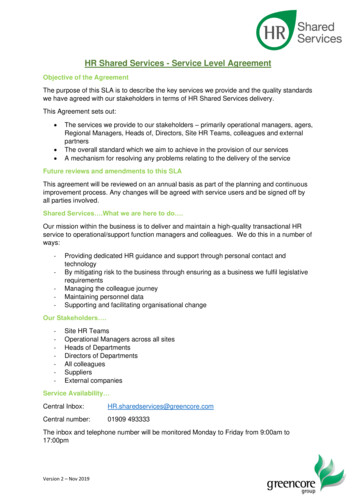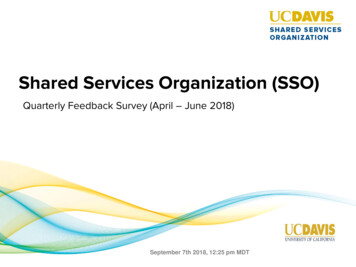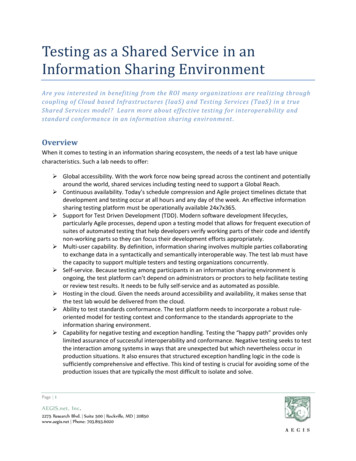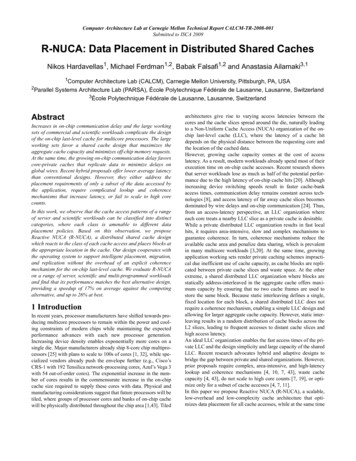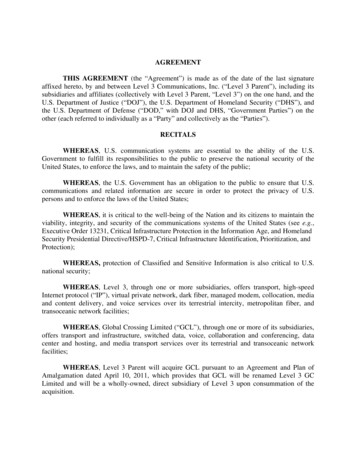
Transcription
Shared Services: what globalcompanies doKey trends and perspectives
Shared Services: what global companies do - Key trends and perspectivesCopyright@2015. Capgemini Consulting. All rights reserved.2
Shared Services: what global companies do - Key trends and perspectivesTable of ContentsExecutive Summary41. Shared Services: an imperative toleverage the size of your company52. Key trends observed7Trend #1: Leveraging outsourcing to boostShared Services7Trend #2: Accelerating globalization of SharedServices in a unified governance8Trend #3: Breaking the silos of functions tooffer integrated services11Trend #4: Offering Analytics services tosupport decision making123. Next Generation Shared Services143
Shared Services: what global companies do - Key trends and perspectivesExecutive SummaryWhen it comes to optimizing support functions of largeglobal companies, Shared Services stand out as animperative to capitalize on size, leverage expertise,improve service quality and increase efficiency.Our research on around 100 multinational companiesshows strong achievements in establishing truly globaldelivery models. Four major trends emerge out of thisresearch: In setting up such models, more than 50% ofcompanies researched are using third partyproviders for the delivery of Shared Services, eithertotally or partially, thus leveraging outsourcing to boostShared Services. Other companies have chosen to retain theirShared Services in-house and have developedregional and/or Global Centers to serve the businessfunctions, integrating them in a unified governance. The traditional functions silos are breaking, functionalscope of Shared Services is increasing and crossfunctional integrated services are being developedto better serve the business.4 Analytics and big data services are rising asnew value-added offerings of Shared Services tosupport business decision making.These trends are shaping what prefigures the NextGeneration Shared Services, now increasingly called‘Global Business Services’. With cost synergies delivered,the new generation of Shared Services is built to focusmore on business value while perpetuating the quest forefficiency.Companies that have set up ‘Global Business Services’have significantly boosted their support functionsperformance, optimizing the cost-quality trade off throughefficiency improvements and a clear shift towards astrong and compelling value proposition to the business.With this major transformation, Next Generation SharedServices are well positioned to be considered full-fledgedpartners of business operations, and not just providers ofservices.
Shared Services: what global companies do - Key trends and perspectives01Shared ServicesAn imperative to leverage the size of your companyShared Services are organizational units handling some activities of support functions for Business Units and Corporate Headquarterswith the aim to deliver the highest standards in terms of quality and efficiency, and in particular to leverage size. In large globalcompanies, they have become well established in the organizational landscape.EXHIBIT 1 Shared Services vs Corporate and Business Units missionsFunctions Missions at CorporateLevel– Corporate Strategy– Policy Making– ControlFunctions Missions at BULevel– Business Strategy– Business Stewardship– Operations SupportCorporateFinanceHRProcITShared ServicesFinanceHRBusiness UnitsFinanceHRProcProcITMissions of Shared Services– Improve Quality of Service Delivery– Optimize Cost to Serve– Increase Agility & ScalabilityITSource: Capgemini Consulting ResearchTraditional scope of Shared ServicesTraditionally, the primary focus of Shared Services hasbeen on delivering support activities in the Finance,HR, Procurement and IT functions. Within thesefunctions, only activities that have a huge potentialfor efficiency improvements are transferred to SharedServices centers. Typically, shared activities across theorganization are transactional, high volume and highlystandardized (example: procure-to-pay and record-toreport processes). The rest are retained activities, whichare maintained in local business units, either becausethey require more business proximity or non-replicablespecific expertise.EXHIBIT 2 Functional processes are generally split into ‘Shared’ and ‘Retained’ bucketsILLUSTRATIONFinance andAccounting Bank Reconciliations Taxation calculation,payments & relatedreconciliations General Ledger Recruitmentadmin Induction Learning &Developmentlogistics andadministration PMS dataprocessing Payroll andbenefitadministration ExitAdministration HR MIS andreporting Billing (Business specific)Audit Management Management & FinancialReporting Treasury Cost Audit, Inventoryverification & valuationInsurance Merger & Acquisition, Budgeting / Capexapproval Taxation specifics(e.g. Sales & Use Tax) HR strategydevelopment Workforceplanning Employeecommunication Employeerelations Employee careerplanning anddevelopment Learning &Development Accounts PayableSharedServicesRetainedHR Employee Traveland Expenses MDM Helpdesk Billing (Generic) Collection Accounting& Debtors reconciliation Fixed assets accountingPayroll Payroll processingand Accounting Employeereimbursements Full and finalsettlements PF Compliance Gratuity &Superannuation Employee Welfare Statutory Returns Time sheet recordingand validationITProcurement Supplier Masterdatamanagement Cataloguemanagement POmanagement Spot buy Categorymanagement StrategicSourcing Requisitioning Supplier QualityReporting RFQ, RFP,RFI IT Helpdesk (localand central) Network & Telcomanagement Data centermanagement Mobility Security Infrastructuremanagement Applicationsustaining Application life cyclemanagement Applicationdevelopment IT strategy Informationarchitecture IT internal auditSource: Capgemini Consulting Research5
Shared Services: what global companies do - Key trends and perspectivesCost savings: what to expect?The market standards on cost savings delivered byshared services range from 15% to up to 40%, mainlydepending on industrialization of processes, level ofautomation and location of centers.Emergence of “core business” sharedservicesCore business activities centralized in Shared Serviceshave existed for long in specific sectors such as: Logistics (global supply chain hubs)However, a new trend is emerging with the setupof Shared Services for core business high-valueactivities which were traditionally retained locally.Capgemini Consulting has supported a leading travelinsurance and assistance company to centralize corebusiness activities through the setup of global centers ofexcellence. After defining a global target operating model,a proof of concept was developed and a pilot regionalhub was implemented in Europe, before the model wasexpanded to other geographies. The strategic movemade by our client aimed at delivering utmost quality ofservice by bundling assistance expertise through regionalhubs thus nurturing top line growth.Key benefits of the new organization are: Retail (global procurement centers) Manufacturing (global production/Final AssemblyLines bundling high end expertise) a reinforced expertise as required by expansion ofcustomer travel destinations the ability to serve global and corporate clients withimproved quality of service a better control of costs allowing to face increasedprice pressure from competition.LogisticsManufacturingRetail6
Shared Services: what global companies do - Key trends and perspectives02Key trends observedWe provide you with key trends in Shared Services based on research conducted by Capgemini Consulting on around100 multinational companies in all sectors, mainly headquartered in the US and Europe.EXHIBIT 3 List of multinational companies included in the nBevBlack & DeckerCoca -ColaEuropcarMaersk LineSABMillerSony PicturesAlcatel Saint -GobainStatoilAlstom TransportBoschDanfossGeneral ElectricMonsantoSandvikSyngentaArcelor MittalBPDellGroupe SEBMotorolaSanofiTetra PakAstra ZenecaBridgestoneDeutsche TelekomGlaxoSmithKlineNestléScandinavian AirlinesThomas CookAvis BudgetBristol-Myers SquibbDHL ExelHenkelNovartisSchlumbergerTRWAvonBritish AirwaysDiageoHoneywellOracleSchneider ElectricUnileverAXABritish TelecomDuPontInternational PaperP&GSearsUnited BiscuitsBASFBureau VeritasE.ONJohnson & JohnsonPepsi CoShellVALEBayerCanonEatonKellog’sPhilip uxKimberley ClarkPublicisSKFVolvo CarsBertelsmannCemexEli LillyLafargeRenaultSociété GénéraleWarner BrosBest BuyChevronEngieLG PhilipsRio TintoSodexoWhirlpool2014 revenue ranges (in USD Bn) of companies represented13%23% 1010-2022%50-100 10012%Source: Capgemini Consulting ResearchTrend #1: Leveraging outsourcing toboost Shared ServicesThe use of third party providers in the delivery of SharedServices is significant: Reaching Finance transactionsPayable, General Ledger)More than 50% of companies researched are usingthird party providers to deliver shared services, eitherin regional or global outsourcing. Evolving to Procurement (e.g. Purchase OrdersProcessing). This trend has been observed in 4 main functionaldomains:(e.g.AccountsOther functions have also been partially or totallyoutsourced. These include but are not limited to facilitiesmanagement, logistics and fleet management. Starting with IT (e.g. Infrastructure, ApplicationMaintenance) Extending to Payroll processing (e.g. Payroll ProcessingSystems)7
Shared Services: what global companies do - Key trends and perspectivesEXHIBIT 4 Companies using third party providers in Shared Services: an illustrationPartial OutsourcingGlobal OutsourcingLimited to selective BUs /geographies / processesExtended to several BUs /geographies / processesCitibankEli LillyStatoilLG PhilipsKimberley ClarkCoca-ColaGlaxoSmithKlineSaint GobainBritish TelecomUnileverNovartisWarner BrosHenkelLindeAlstom TransportArcelorSandvikFedExProcter & GambleDiageoCanonAlcatel LucentHoneywellThomas CookRio TintoBristol-MyersSquibbGeneral ElectricSyngentaDHLTetra PakMichelinPepsi CoSanofiAvonSABMillerScandinavianAirlinesAstra ZenecaSearsSolvayDanfossUnited BiscuitsCemexBPSchlumbergerSociété GénéraleInternationalPaperSKFVolvo CarsSource: Capgemini Consulting ResearchThe increase in the use of third party providers stems froma more mature and competitive outsourcing market with:Trend #2: Accelerating globalization ofShared Services in a unified governance An unmatched global footprint developed byoutsourcers in both ITO (IT outsourcing) and BPO(Business Process Outsourcing), having clientsbenefit from a very large choice of worldwide locations,as determined by the company’s strategy;Companies that kept their shared services in-housedeveloped Regional and/or Global Centers: a recentstudy1 shows 76% of companies survey have adopteda regional model or a global business services model. A global network of interoperable centers builtby providers, offering their clients the agility to shiftactivities from one center to another, as dictated bystructural or internal business evolutions (acquisitions,divestitures, etc.); A continuous quest for excellence in delivery andefficiency optimization, through the possibility totransfer centers to locations that offer the best costarbitrage-quality tradeoff.8Shared Services centers are now set up and managedas autonomous business units, with increased levels ofprofessionalization and a dedicated governance structure.The rationale for setting up regional or global in-houseshared services across the company is largely dependenton the industry and the nature of business activities.Source 1 : State of the Shared Services Industry Report, 2014 SSON(Shared Services Organization Network) Annual Survey
Shared Services: what global companies do - Key trends and perspectivesSharing support functions resources across countries is alever for improving efficiency and ensuring effectiveness.Main reasons for this organizational move include:The drivers for setting up regional or global shared servicescenters will be different. Regional shared services will bepreferred over global when: Building expertise Business proximity is needed Leveraging economies of scale Language capabilities are constraining Standardizing transactional processes Activities are time zone dependent. Increasing professionalismThe push towards a global Shared Services center will bemade when: Focusing countries on core business. Activities transferred are not time zone dependent Size of activities is enough to build large scale centersin highly competitive locations, thus offering the bestcost-quality tradeoff.EXHIBIT 5 Selected examples of regional and global Shared Services Centers (captive)CompanyRegional centers (countries or processes served)Global centersIndustrial conglomerate Buenos Aires, Argentina (Americas),Beijing, China (China, Japan)Lisbon, Portugal (South & Western Europe)Prague, Czech Republic (Central & Eastern Europe) Bangalore,IndiaLeader in the oil and gas industry Houston, USA (North America for all Functions, Latin AmericaFinance)Kuala Lumpur, Malaysia (MEA, Asia for all Functions, Europe forFinance)Bogota, Colombia (Latin America HR)Bucharest, Romania (Procurement Europe)Leader in the oil and gas industry Glasgow, Scotland (Global Finance)Kuala Lumpur, Malaysia (Multi-function SSC)Cape Town, South Africa (Customer Services)Krakow, Poland Chennai, India Manila, PhilippinesLeader in the chemicals industry Berlin, Germany (Europe)Sao Paulo, Argentina (Latin America)Florham Park, USA (North America)Kuala Lumpur, Malaysia (Asia)Shanghai, China (Asia Pacific Procurement) Mumbai, IndiaLeader in the chemicals industry Lisbon, Portugal (Europe)Curitiba, Brazil (Americas)Bangkok, Thailand (Asia)Brussels, Cranbury, L
– Business Strategy – Business Stewardship – Operations Support M i son f Sha r ed v c Sha r ed vic s Finance HR Proc IT Business Units Finance HR Proc IT Functions Missions at CorporateLevel Functions Missions at BULevel – – Optimize Cost to Serve – Increase Agility & Scalability Improve Quality of Service Delivery Shared Services Retained Payroll processinga and Accounting .
